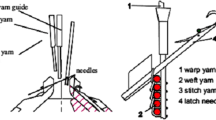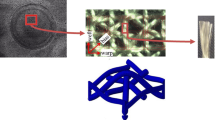Abstract
Three-dimensionally (3D) knitted technical textiles are spreading into industrial applications, since their geometric, structural and functional performance can be tailored and optimized on fibre-, yarn- and fabric levels by customizing yarn materials, knit patterns and geometric shapes. The ability to simulate their complex mechanical behaviour is thus an essential ingredient in the development of a digital workflow for optimal design and manufacture of 3D knitted textiles. Here, we present a multi-scale modelling and simulation framework for the prediction of the nonlinear orthotropic mechanical behaviour of single jersey knitted textiles and its experimental validation. On the meso-scale, representative volume elements (RVEs) of the fabric are modelled as single, interlocked yarn loops and their mechanical deformation behaviour is homogenized using periodic boundary conditions. Yarns are modelled as nonlinear 3D beam elements and numerically discretized using an isogeometric collocation method, where a frictional contact formulation is used to model inter-yarn interactions. On the macro-scale, fabrics are modelled as membrane elements with nonlinear orthotropic material behaviour, which is parameterized by a response surface constitutive model obtained from the meso-scale homogenization. The input parameters of the yarn-level simulation, i.e., mechanical properties of yarns and geometric dimensions of yarn loops in the fabrics, are determined experimentally and subsequent meso- and macro-scale simulation results are evaluated against reference results and mechanical tests of knitted fabric samples. Good agreement between computational predictions and experimental results is achieved for samples with varying stitch values, thus validating our novel computational approach combining efficient meso-scale simulation using 3D beam modelling of yarns with numerical homogenization and nonlinear orthotropic response surface constitutive modelling on the macro-scale.








Similar content being viewed by others
References
Leong, K.H., Ramakrishna, S., Huang, Z.M., Bibo, G.A.: The potential of knitting for engineering composites—a review. Composites Part A. 31(3), 197–220 (2000)
de Araujo, M., Fangueiro, R., and Hong, H.: Modelling and simulation of the mechanical behaviour of weft-knitted fabrics for technical applications. Autex Res. J. 4(2), 2004
Underwood, J.: The Design of 3D Shape Knitted Performs. School of Fashion and Textiles, RMIT University, 2009
Abel, J., Luntz, J., and Brei, D.: Hierarchical architecture of active knits. Smart Mater. Struct. 22(12), 2013
Ball, E.J., Meller, M.A., Chipka, J.B., and Garcia, E.: Modeling and testing of a knitted-sleeve fluidic artificial muscle,” Smart Mater. Struct. 25(11), 2016
Glazzard, M., Breedon, P.: Weft-knitted auxetic textile design. Phys. Status Solidi B. 251(2), 267–272 (2014)
Hong, H., De Araujo, M.D., Fangueiro, R., Ciobanu, O.: Theoretical analysis of load-extension properties of plain weft knits made from high performance yarns for composite reinforcement. Text. Res. J. 72(11), 991–996 (2002)
Kaldor, J.M., James, D.L., Marschner, S.: “Simulating knitted cloth at the yarn level,” in ACM trans. Graphics (TOG). 27, 65 (2008)
Shiryaev, V., Orlik, J.: A one-dimensional computational model for hyperelastic string structures with coulomb friction. Math. Meth. Appl. Sci. 40(3), 741–756 (2017)
Orlik, J., Panasenko, G., Shiryaev, V.: Optimization of textile-like materials via homogenization and beam approximations. Multiscale Model. Simul. 14(2), 637–667 (2016)
Vassiliadis, S.G., Kallivretaki, A.E., Provatidis, C.G.: Mechanical simulation of the plain weft knitted fabrics. Int. J. Clothing Sci. Technol. 19(2), 109–130 (Mar. 2007)
Liu, D., et al.: On the role of material architecture in the mechanical behavior of knitted textiles. Int. J. Solids Struct. 109, 101–111 (2017)
Fillep, S., Orlik, J., Bare, Z., Steinmann, P.: Homogenization in periodically heterogeneous elastic bodies with multiple micro-contact. Math. Mech. Solids. 19(8), 1011–1021 (2014)
Geers, M.G.D., Kouznetsova, V.G., Matouš, K., Yvonnet, J.: Homogenization Methods and Multiscale Modeling: Nonlinear Problems, in Encyclopedia of Computational Mechanics, 2 Ed, Wiley, 2017
Yeoman, M.S., Reddy, D., Bowles, H.C., Bezuidenhout, D., Zilla, P., Franz, T.: A constitutive model for the warp-weft coupled non-linear behavior of knitted biomedical textiles. Biomaterials. 31(32), 8484–8493 (2010)
Widhammer, A.M.: Variation of Reference Strategy - Generation of Optimized Cutting Patterns for Textile Fabrics. Ingenieurfakultät Bau Geo Umwelt, Technische Universität München, 2015
Coelho, M., Roehl, D., Bletzinger, K.-U.: Material model based on NURBS response surfaces. Appl. Math. Model. 51, 574–586 (2017)
Vassiliadis, S., Kallivretaki, A.E., Provatidis, C.G.: Geometrical modelling of plain weft knitted fabrics. Indian J. Fibre Textile Res. 32, 62–71 (2007)
Eugster, S.: Geometric Continuum Mechanics and Induced Beam Theories, vol. 75. Springer International Publishing, 2015
Weeger, O., Yeung, S.-K., Dunn, M.L.: Isogeometric collocation methods for Cosserat rods and rod structures. Comput. Methods Appl. Mech. Eng. 316, 100–122 (2017)
Weeger, O., Narayanan, B., Lorenzis, L.D., Kiendl, J., Dunn, M.L.: An isogeometric collocation method for frictionless contact of Cosserat rods. Comput. Methods Appl. Mech. Eng. 321, 361–382 (2017)
Kiendl, J., Hsu, M.-C., Wu, M.C.H., Reali, A.: Isogeometric Kirchhoff–love shell formulations for general hyperelastic materials. Comput. Methods Appl. Mech. Eng. 291, 280–303 (2015)
Acknowledgements
The authors acknowledge funding through the SUTD Digital Manufacturing and Design (DManD) Centre, supported by the Singapore National Research Foundation.
Author information
Authors and Affiliations
Corresponding author
Rights and permissions
About this article
Cite this article
Weeger, O., Sakhaei, A.H., Tan, Y.Y. et al. Nonlinear Multi-Scale Modelling, Simulation and Validation of 3D Knitted Textiles. Appl Compos Mater 25, 797–810 (2018). https://doi.org/10.1007/s10443-018-9702-4
Received:
Accepted:
Published:
Issue Date:
DOI: https://doi.org/10.1007/s10443-018-9702-4




